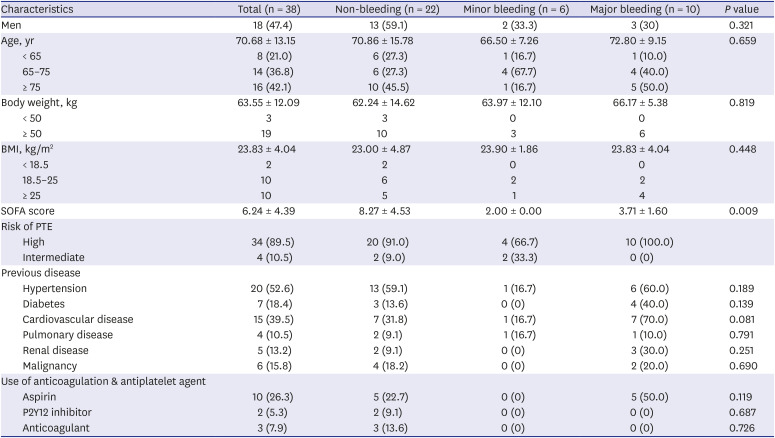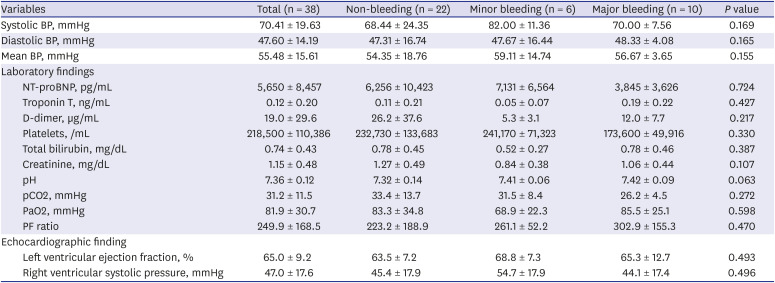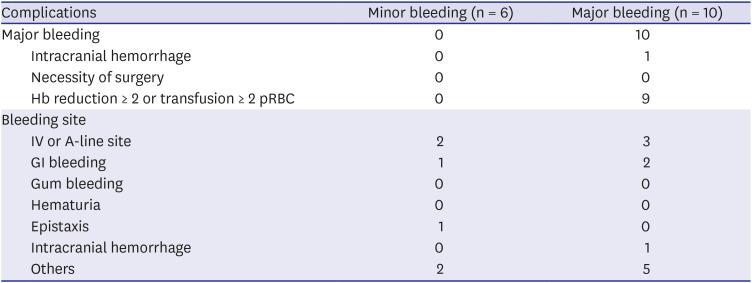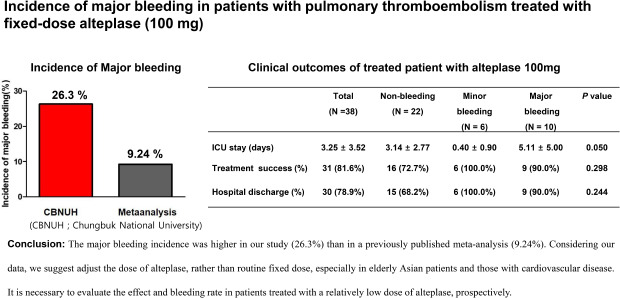1. Konstantinides SV, Torbicki A, Agnelli G, Danchin N, Fitzmaurice D, Galiè N, et al. 2014 ESC guidelines on the diagnosis and management of acute pulmonary embolism. Eur Heart J. 2014; 35(43):3033–3069. 3069a–3069k. PMID:
25173341.
2. Goldhaber SZ, Visani L, De Rosa M. Acute pulmonary embolism: clinical outcomes in the International Cooperative Pulmonary Embolism Registry (ICOPER). Lancet. 1999; 353(9162):1386–1389. PMID:
10227218.

3. Stein PD, Beemath A, Olson RE. Trends in the incidence of pulmonary embolism and deep venous thrombosis in hospitalized patients. Am J Cardiol. 2005; 95(12):1525–1526. PMID:
15950590.

4. Park TY, Jung JW, Choi JC, Shin JW, Kim JY, Choi BW, et al. Epidemiological trend of pulmonary thromboembolism at a tertiary hospital in Korea. Korean J Intern Med. 2017; 32(6):1037–1044. PMID:
28286939.

5. Hong J, Lee JH, Yhim HY, Choi WI, Bang SM, Lee H, et al. Incidence of venous thromboembolism in Korea from 2009 to 2013. PLoS One. 2018; 13(1):e0191897. PMID:
29370290.

6. Capstick T, Henry MT. Efficacy of thrombolytic agents in the treatment of pulmonary embolism. Eur Respir J. 2005; 26(5):864–874. PMID:
16264048.

7. Meyer G, Vicaut E, Danays T, Agnelli G, Becattini C, Beyer-Westendorf J, et al. Fibrinolysis for patients with intermediate-risk pulmonary embolism. N Engl J Med. 2014; 370(15):1402–1411. PMID:
24716681.

8. Rieves D, Wright G, Gupta G, Shacter E. Clinical trial (GUSTO-1 and INJECT) evidence of earlier death for men than women after acute myocardial infarction. Am J Cardiol. 2000; 85(2):147–153. PMID:
10955368.

9. Collen D. Molecular mechanism of action of newer thrombolytic agents. J Am Coll Cardiol. 1987; 10(5 Suppl B):11B–15B.

10. Hao Z, Yang C, Liu M, Wu B. Renal dysfunction and thrombolytic therapy in patients with acute ischemic stroke: a systematic review and meta-analysis. Medicine (Baltimore). 2014; 93(28):e286. PMID:
25526464.
11. Armstrong PW, Gershlick AH, Goldstein P, Wilcox R, Danays T, Lambert Y, et al. Fibrinolysis or primary PCI in ST-segment elevation myocardial infarction. N Engl J Med. 2013; 368(15):1379–1387. PMID:
23473396.

12. Anderson CS, Robinson T, Lindley RI, Arima H, Lavados PM, Lee TH, et al. Low-dose versus standard-dose intravenous alteplase in acute ischemic stroke. N Engl J Med. 2016; 374(24):2313–2323. PMID:
27161018.
13. Sharifi M, Bay C, Skrocki L, Rahimi F, Mehdipour M. “MOPETT” Investigators. Moderate pulmonary embolism treated with thrombolysis (from the “MOPETT” Trial). Am J Cardiol. 2013; 111(2):273–277. PMID:
23102885.

14. Zhang Z, Zhai ZG, Liang LR, Liu FF, Yang YH, Wang C. Lower dosage of recombinant tissue-type plasminogen activator (rt-PA) in the treatment of acute pulmonary embolism: a systematic review and meta-analysis. Thromb Res. 2014; 133(3):357–363. PMID:
24412030.

15. Yilmazel Ucar E, Araz O, Kerget B, Yilmaz N, Akgun M, Saglam L. Comparison of long-term outcomes of 50 and 100 mg rt-PA in the management of acute pulmonary thromboembolism. Clin Respir J. 2018; 12(4):1628–1634. PMID:
29044967.
16. Yoo JW, Kim W, Choi CM, Hong SB, Oh YM, Shim TS, et al. The therapeutic efficacy and the bleeding complications of urokinase and alteplase in patients with massive pulmonary thromboembolism. Tuberc Respir Dis. 2009; 66(1):6.

17. Meyer G, Gisselbrecht M, Diehl JL, Journois D, Sors H. Incidence and predictors of major hemorrhagic complications from thrombolytic therapy in patients with massive pulmonary embolism. Am J Med. 1998; 105(6):472–477. PMID:
9870831.

18. Chatterjee S, Chakraborty A, Weinberg I, Kadakia M, Wilensky RL, Sardar P, et al. Thrombolysis for pulmonary embolism and risk of all-cause mortality, major bleeding, and intracranial hemorrhage: a meta-analysis. JAMA. 2014; 311(23):2414–2421. PMID:
24938564.

19. Schulman S, Kearon C. Subcommittee on Control of Anticoagulation of the Scientific and Standardization Committee of the International Society on Thrombosis and Haemostasis. Definition of major bleeding in clinical investigations of antihemostatic medicinal products in non-surgical patients. J Thromb Haemost. 2005; 3(4):692–694. PMID:
15842354.

20. Martin C, Sobolewski K, Bridgeman P, Boutsikaris D. Systemic thrombolysis for pulmonary embolism: a review. P T. 2016; 41(12):770–775. PMID:
27990080.
21. Kwak SH, Jeong CW, Lee SH, Lee HJ, Koh Y. Current status of intensive care units registered as critical care subspecialty training hospitals in Korea. J Korean Med Sci. 2014; 29(3):431–437. PMID:
24616595.

22. Dalla-Volta S, Palla A, Santolicandro A, Giuntini C, Pengo V, Visioli O, et al. PAIMS 2: alteplase combined with heparin versus heparin in the treatment of acute pulmonary embolism. Plasminogen activator Italian multicenter study 2. J Am Coll Cardiol. 1992; 20(3):520–526. PMID:
1512328.

23. Goldhaber SZ, Haire WD, Feldstein ML, Miller M, Toltzis R, Smith JL, et al. Alteplase versus heparin in acute pulmonary embolism: randomised trial assessing right-ventricular function and pulmonary perfusion. Lancet. 1993; 341(8844):507–511. PMID:
8094768.

24. Konstantinides S, Geibel A, Heusel G, Heinrich F, Kasper W. Management Strategies and Prognosis of Pulmonary Embolism-3 Trial Investigators. Heparin plus alteplase compared with heparin alone in patients with submassive pulmonary embolism. N Engl J Med. 2002; 347(15):1143–1150. PMID:
12374874.

25. Fasullo S, Scalzo S, Maringhini G, Ganci F, Cannizzaro S, Basile I, et al. Six-month echocardiographic study in patients with submassive pulmonary embolism and right ventricle dysfunction: comparison of thrombolysis with heparin. Am J Med Sci. 2011; 341(1):33–39. PMID:
20890176.

26. Chatzikonstantinou A, Ebert AD, Wolf ME. The impact of body mass index on the thrombolytic treatment of acute ischemic stroke. Cerebrovasc Dis. 2016; 42(3-4):240–246. PMID:
27173490.

27. Misumida N, Ogunbayo GO, Kim SM, Olorunfemi O, Elbadawi A, Charnigo RJ, et al. Higher risk of bleeding in Asians presenting with ST-segment elevation myocardial infarction: analysis of the national inpatient sample database. Angiology. 2018; 69(6):548–554. PMID:
28905638.

28. Kim YD, Jung YH, Saposnik G. Traditional risk factors for stroke in East Asia. J Stroke. 2016; 18(3):273–285. PMID:
27733028.









 PDF
PDF Citation
Citation Print
Print




 XML Download
XML Download